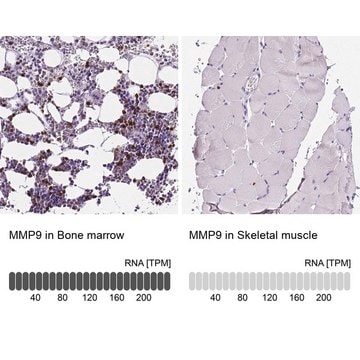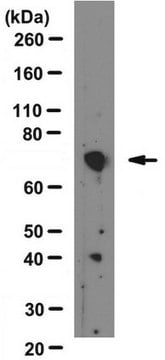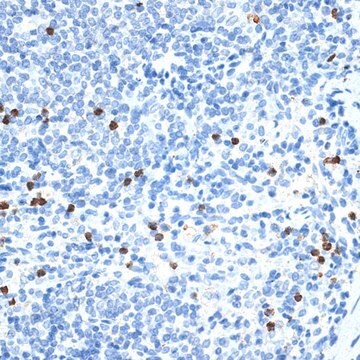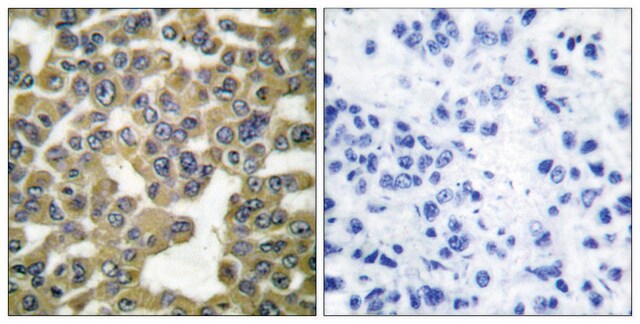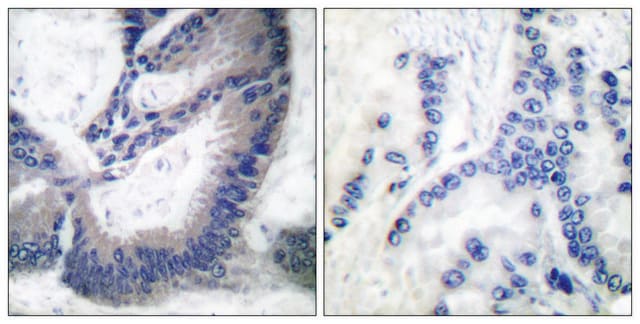추천 제품
생물학적 소스
rabbit
Quality Level
결합
unconjugated
항체 형태
IgG fraction of antiserum
항체 생산 유형
primary antibodies
클론
polyclonal
양식
buffered aqueous solution
분자량
78 kDa
종 반응성
human, dog, mouse, guinea pig, horse, bovine, sheep, rat, rabbit
농도
0.5 mg - 1 mg/mL
기술
immunohistochemistry: suitable
western blot: suitable
NCBI 수납 번호
UniProt 수납 번호
배송 상태
wet ice
저장 온도
−20°C
타겟 번역 후 변형
unmodified
유전자 정보
human ... MMP9(4318)
일반 설명
Matrix metalloproteinase-9/gelatinase B (MMP-9), a member of the matrix metalloproteinase (MMP) family, is involved in the breakdown of extracellular matrix giving it a role in normal physiological processes such as embryonic development, tissue remodeling, wound repair, vascularization and inflammatory response. MMP-9 is involved in synaptic plasticity. MMP-9 functions in modulating hippocampal synaptic physiology and plasticity.
면역원
Synthetic peptide directed towards the N terminal region of human MMP9
애플리케이션
Applications in which this antibody has been used successfully, and the associated peer-reviewed papers, are given below.
Western Blotting (1 paper)
Western Blotting (1 paper)
Rabbit polyclonal anti-MMP9 antibody is used to tag matrix metalloproteinase-9/gelatinase B for detection and quantitation by immunocytochemical and immunohistochemical (IHC) techniques. It is used as a probe to determine the presence and roles of matrix metalloproteinase-9/gelatinase B in processe such as synaptic plasticity.
생화학적/생리학적 작용
Proteins of the matrix metalloproteinase (MMP) family are involved in the breakdown of extracellular matrix in normal physiological processes, such as embryonic development, reproduction, and tissue remodeling, as well as in disease processes, such as arthritis and metastasis. Most MMP′s are secreted as inactive proproteins which are activated when cleaved by extracellular proteinases. The enzyme encoded by MMP9 degrades type IV and V collagens. Studies in rhesus monkeys suggest that the enzyme is involved in IL-8-induced mobilization of hematopoietic progenitor cells from bone marrow, and murine studies suggest a role in tumor-associated tissue remodeling.
서열
Synthetic peptide located within the following region: VAEHGDGYPFDGKDGLLAHAFPPGPGIQGDAHFDDDELWSLGKGVVVPTR
물리적 형태
Purified antibody supplied in 1x PBS buffer with 0.09% (w/v) sodium azide and 2% sucrose.
면책조항
Unless otherwise stated in our catalog or other company documentation accompanying the product(s), our products are intended for research use only and are not to be used for any other purpose, which includes but is not limited to, unauthorized commercial uses, in vitro diagnostic uses, ex vivo or in vivo therapeutic uses or any type of consumption or application to humans or animals.
적합한 제품을 찾을 수 없으신가요?
당사의 제품 선택기 도구.을(를) 시도해 보세요.
Storage Class Code
10 - Combustible liquids
WGK
WGK 3
Flash Point (°F)
Not applicable
Flash Point (°C)
Not applicable
가장 최신 버전 중 하나를 선택하세요:
이미 열람한 고객
Prashant Nighot et al.
American journal of physiology. Gastrointestinal and liver physiology, 309(12), G988-G997 (2015-10-31)
Recent studies have implicated a pathogenic role for matrix metalloproteinases 9 (MMP-9) in inflammatory bowel disease. Although loss of epithelial barrier function has been shown to be a key pathogenic factor for the development of intestinal inflammation, the role of
K Nagaoka et al.
Oncogene, 35(22), 2893-2901 (2015-09-29)
In mouse mammary epithelial cells, cytoplasmic polyadenylation element binding protein 1 (CPEB1) mediates the apical localization of ZO-1 mRNA, which encodes a critical tight junction component. In mice lacking CPEB1 and in cultured cells from which CPEB has been depleted
Mirel-Adrian Popa et al.
Journal of molecular endocrinology, 60(1), 1-15 (2017-12-17)
The use of mesenchymal stem cells (MSC) as a therapeutic tool in cardiovascular diseases is promising. Since androgens exert some beneficial actions on the cardiovascular system, we tested our hypothesis that this hormone could promote MSC-mediated repair processes, also. Cultured
Dong Zhao et al.
Molecular medicine reports, 14(6), 4983-4990 (2016-11-15)
Tanshinone II A (TSIIA) is a diterpene quinone extracted from the roots of Salvia miltiorrhiza with anti-inflammatory and anti‑oxidant properties that is used to treat atherosclerosis. In the current study, morphological analyses were conducted to evaluate the effects of TSIIA on
Fengwu Li et al.
Cell transplantation, 28(2), 145-156 (2018-12-21)
Ischemic stroke destroys blood-brain barrier (BBB) integrity. There are currently no effective treatments available in the clinical setting. Post-ischemia treatment with phenothiazine drugs [combined chlorpromazine and promethazine (C+P)] has been shown to be neuroprotective in stroke. The present study determined
자사의 과학자팀은 생명 과학, 재료 과학, 화학 합성, 크로마토그래피, 분석 및 기타 많은 영역을 포함한 모든 과학 분야에 경험이 있습니다..
고객지원팀으로 연락바랍니다.